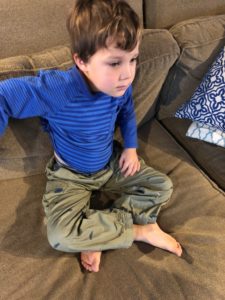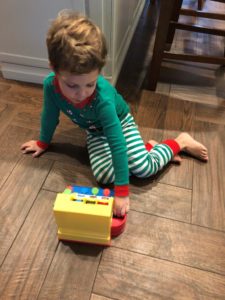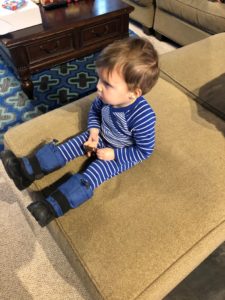I get asked all the time “What is W-sitting anyway?” and “Why is W-sitting bad for my child?” and “What should I do to correct a W-sitter?”
I am writing this to inform and educate. As a pediatric occupational therapist, I treat children who have motor difficulties, some stemming from spending too much time in atypical positions, like W-sitting. If you are concerned that W-sitting is putting your child at risk for other developmental issues, please talk to your pediatrician.
W-sitting is a position that some children use while seated on the floor, with their bottoms touching the ground and their legs bent at the knees and turned out away from their core. When you look from above at a child sitting this way on the floor, the position resembles the letter W.
How Does it Start?
W-sitting is not an uncommon position for babies to experiment with as they develop gross motor skills to move from the floor to upright. They spend time in several different postures as they get to sitting, kneeling, and pulling up to stand. Spending too much time on the floor W-sitting can be a compensation for decreased postural control. A child like this may have weak core muscles or poor sitting balance. Sitting in a W-position creates a stable and wider base of support, making it easier to play without falling, but comes with a list of negatives.
What are the Risks?
Okay, here is the dangerous part. It’s important to me to tell you WHY it’s bad for children. I know plenty of people say “I sat like that my whole life and I’m fine”. But developmentally it is a problematic position and here is why:
- Limited trunk rotation – In W-sitting, it is hard to move side to side to turn or reach toys beyond that base of support. This type of rotational movement is important for strengthening the core, crossing midline, developing bilateral (two handed skills) and establishing a hand preference. W-sitting also can impact the development of more sophisticated fine motor skills like writing and cutting.
- Hip issues – Prolonged W-sitting can result in tightening of the hip ligaments. This position puts a lot of pressure on the joints as it uses them for stability, instead of engaging the core muscles. Some children have un-diagnosed hip dysplasia and W-sitting can exacerbate it – contributing to hip dislocation. I’ve treated many clients with tight hip muscles from W-sitting, who can’t maintain other (safer) seated positions for more than a few seconds.
- Long term orthopedic issues – Prolonged rotation of the legs and resultant tight hip muscles can negatively impact walking patterns. Some children become “pigeon toed”, or stand in a “knock knee” position. These types of issues compromise safe movement, participation in sports or physical activity, and result in long-term physical stress on joints.
How Can I Fix it?
Change positions. Whenever I see a preschooler W-sitting I so desperately want to utter “Fix your legs!” Remember the preschool and kindergarten teachers who work with the group during circle time to sit cross legged? This helps the W-sitters of the world! Depending on the age of the student, they might be sensitive to some crazy lady therapist always reminding them to sit better. I have worked with some clients to find a verbal cue that helps to remind them to change their seated position. Here are a few:
– “No W’s at school”
– “How about XYZ (instead of the W)”
– “Criss-cross applesauce!”
Eventually most kids respond to calling their name and the raised eyebrow. Whatever it is – encourage the child to sit differently – a kneeling position can work (knees together), tailor sit (criss-cross), side sitting, long sitting, or folding in one leg. Just vary the position and try to build tolerance/endurance outside of W-sitting. Sitting on a small ball or a short stool can help too, if other positions are difficult at first.



Yes, some kids sit this way for a short while, and their adults (like me) lift an eyebrow and hone in (it looks SO uncomfortable). Just keep watch over what positions they move in/out of and how long they stay there. Babies and young toddlers have very flexible joints and generally don’t stay in one position long enough to do damage. For an older child, if W-sitting is the preferred position, then its time to switch it up! Good Luck!










